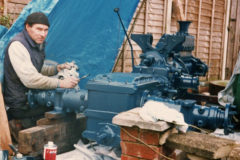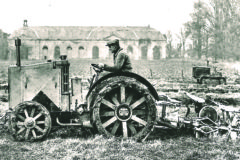One of the smallest John Deeres ever?
Posted by Chris Graham on 5th November 2020
Andy Burroughs owns one of the smallest John Deeres ever, a 1940 Model L, as Peter Henshaw discovers.

One of the smallest: The John Deere Model L, with Dreyfuss styling, is a neat little tractor.
People own smaller tractors for many reasons. They are easier to transport to shows and less intimidating to drive. What’s more, all else being equal, they often work out cheaper to buy and restore, as well. For Andy Burroughs, his reasons for buying one of the smallest John Deeres tractors relates to a change of job and a lack of space.
The son of a tractor driver, he started work aged 18 on a farm devoted to John Deere, and his first works tractor was a 3640. By the late 1980s, he was driving a six-cylinder 4055, which was one of the biggest machines working in Somerset at the time. Meanwhile, he was getting interested in older tractors, starting with a Fordson E27N followed by a Marshall VF, then a BTD-6 International. Working on a farm meant that storage wasn’t a problem.

A snapshot of working life from 1959 to ‘73 adds to the tractor’s provenance.
Unfortunately, when the boss’s son came back to work on the family farm, it meant redundancy for Andy. However, he already had a Class I HGV licence for hauling his own old tractors around, so quickly found a job delivering milk to supermarkets, which he’s been doing ever since. The bigger problem was that leaving the farm meant he would have nowhere to keep his tractors, nor access to an HGV to take them to shows. To someone living in a bungalow, that meant moving to smaller tractors and, for someone with so much John Deere experience, there was an obvious choice. “I’d always fancied the Model L, so when this one came up, I had to have it,” he said. “It’s small enough to fit in a small box trailer, towed behind my pick-up, so storage and transport are easier.”
Getting his tractors to shows is especially important. He’s always taken an active part in rallies, and has been on the committee for Somerset’s long-running Abbey Hill Steam Rally for 38 years – 2020 would have been Abbey Hill’s 40th. We all know what happened to outside events this year! Not that he’s only interested in tractors. Smaller projects include a JD stationary engine, and a mobility scooter that’s been converted into a miniature steam lorry. The latter was built from a kit, complete with distilled water that’s dripped on to a hot plate, to produce authentic steam.
New market
The original L is a strong contender for John Deere’s most forgotten tractor. We all know about the first Waterloo Boy, and the generations of Johnny Poppers which followed. Then the New Generation of four- and six-cylinder tractors which propelled the company through the 1960s, ‘70s and beyond. But back in the mid-1930s, JD realised it was missing out on a growing market for smaller machines than its traditional big twins. From livestock farms which needed a second tractor for yard-scraping, to smaller arable farmers, market gardeners and landscapers, there was a demand for a small, lightweight tractor which would do the work of two horses, but at a higher speed.

John Deere responded but, being the conservative company it was, didn’t rush straight into production. A prototype – the Model Y – was built at Deere’s Wagon Works factory in 1936. It broke with tradition by featuring a vertical, twin-cylinder engine (not JD’s traditional horizontal layout), possibly to keep the overall length down. It was a simple machine with a two-bar chassis and no hydraulics or PTO. Twenty-four Model Ys were built and must have been judged a success as, in the summer of 1937, John Deere followed it with the updated Model 62, though even this one was still limited to a small production run, to test the market.
Later that year, the full production Model L was launched. Like the 62, it was powered by a small, vertical twin, designed in-house but built for the company by engine manufacturer, Hercules. It may have been that John Deere didn’t have enough capacity to make the engine itself but, either way, the water-cooled twin proved successful, delivering 10.42hp at the belt when tested at Nebraska, the following year. That was easily enough to do the work of a two-horse team.
Speed upgrade
With a rated speed of 1,550rpm and a three-speed transmission, the little Model L could work at up to 6mph, though one option was a ‘transport speed attachment’ which increased rated speed to 2,400rpm and 10mph – for ‘on-road use only’, as the instruction book put it. An offset driving position (engine to the right and driver’s seat and steering wheel to the left) gave a less obstructed view of the left-hand front wheel and, of course, this short, tight-turning tractor was highly manoeuvrable.

Even simple, small tractors need some maintenance.
The L wasn’t a big seller by John Deere standards, with production averaging 2,000 a year over 10 years, but it gave the company a useful toehold in a different market. In any case, if a satisfied Model L owner needed to buy a bigger tractor one day, they’d be more likely to make John Deere their first stop. So, the L got some developments and updates over its life. A bright yellow industrial version – the LI – followed in 1938, with road tyres and a top speed of 8.5mph.
Panels restyled
At the time, John Deere tractors were getting a sheet metal makeover from renowned industrial stylist, Henry Dreyfuss, and the L was no exception. The changes weren’t as comprehensive as on the bigger machines, but reshaping the bonnet gave this boxy little tractor a modicum of style. The same year (it was a busy one for the small John Deeres), the Model H was unveiled. It was a 13hp tractor, but more of a mini row-crop machine, with a return to the horizontal engine layout.
It was joined in 1940 by the LA, with a larger version of the L’s engine, plus 28-inch rear wheels, 40% more power and wheel weights to help curb that 14hp. In the meantime, production of the L/LA engine was taken over by John Deere, ending the deal with Hercules. Both L and LA tractors were dropped in 1946, the H following in 1947, with all three small tractors being replaced by the 19.5hp Model M. All were gone, but hopefully not forgotten.

The Model L is small enough to be driven into the box trailer, but Andy still has to duck!
Respray surprise
Andy Burrough’s L is a 1940 example, so it probably came over as part of the Lend-Lease deal between the US and Britain during the Second World War. Andy’s L had worked on a farm in Devon, and had a registration from the same county, so was obviously used on the road. It arrived with tax discs dating back to 1959.
He bought it from John Thorn, whose father had owned the tractor during the war, so Andy is probably only its second owner from new. It even came with the original chassis plate, which is apparently rare. Andy explained that these often get knocked off, as they’re fixed to the rear axle where the driver’s foot lands when climbing aboard. His isn’t in place at the moment.
The good news was that the Lend-Lease L needed little doing to it, John having restored the engine and gearbox. “It was in reasonable nick and I wasn’t intending to paint it,” said Andy, “but I took it to a friend who would give it a good clean up and polish. When I came back to pick it up, I found he’d resprayed it for me! He’d had little on that week, so just got on with it.” Nice to have friends like that!

“It’s a pretty little tractor and attracts a lot of attention at shows,” Andy says.
So, Andy could get straight on with enjoying the L. It’s tricky to start from cold, and he thinks the mag needs overhauling, though it started straight up on the handle the morning I was there. He especially likes its manoeuvrability, and the fact that it can be squeezed it into the back of a box trailer.
“It’s a pretty little tractor and attracts a lot of attention at shows,” he reflected. “But one of the best things I’ve done with it was a field run at a local farm – like a road run, but on grass. There was one very steep hill, but I put it in bottom gear and it just chugged up at walking pace, and it didn’t miss a beat over three hours.”
For a money-saving subscription to Tractor & Farming Heritage magazine, simply click here





